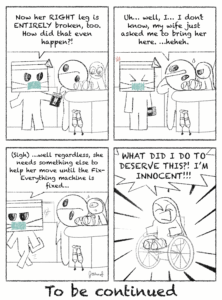The equation that models gravitational force between two celestial bodies is almost identical to the one that models the magnetic force between two point charges. The forces holding our universe together—at the largest scale and at the smallest—are only discernible by a couple of different variables.
The photographs we have of our universe are 13 billion years old. What we see is not our reality. Light moves swiftly, but not swiftly enough, and the here and now has not arrived yet to our little corner of the cosmos. We look out into the stars and into our past, wondering at what the sky will look like when it catches up to us.
When we talk about science, when we talk about our world and our universe, we do not only speak in hard formulas, concepts, and equations. We do not speak in right or wrong answers. We speak in poetry.
The Law of Conservation of Mass states that matter is never created or destroyed, merely transformed from one form to another. We could think about our world that way; some people do. But we could also think about all the stars that died for us to be here. Every atom in our bodies was once part of a star—carbon, nitrogen, oxygen, and so on—all stardust, running through our veins. These both say the same thing in different ways.
Is one way of thinking wrong? Is one right? My mother, a former physicist here at the University, was firm in the lessons she taught me. “Don’t lose your science,” she would tell me, “Draw, paint, write, but whatever you do, don’t lose your science. Women always lose their science.”
Yet every time I say that I am majoring in mechanical engineering, eyebrows raise and the reaction is usually along the lines of, “I could never do that, I’m not a science person.”
Of course, it goes both ways. For every English or humanities major who claims, “I’m just not good at math,” there’s an engineer who bemoans, “I’m terrible at writing.”
These comments are familiar landmarks in what seems to be an everlasting tug-of-war between the humanities and the hard sciences. But they also suggest a deeper and more concerning viewpoint that seems to be increasingly prevalent: that you either you’re a “science” person, or you’re not.
This idea, that one side of your brain dominates your way of thinking, is not only untrue, but it perpetuates the idea that the humanities and the sciences are separate, mutually-exclusive disciplines—that you can only do one.
If you had absolutely no interest in chemistry or improving your creative writing, why would you study it? We challenge ourselves most in the things that thrill us and thus, become more adept in them. Math is a skill. Writing is a skill. You work for these skills. You may have a predisposition to succeed in one discipline, but that does not mean you cannot also excel in another.
To suggest that you must be naturally skilled in a subject to succeed in it disrespects the centuries of advancements and achievements that each field has earned through hours of dedicated work by passionate scholars. And even further, it disrespects the hard work and research done every day by students and professors here at the University.
The story sometimes goes that the humanities are easier because there are thousands of right answers, and you are seldom wrong. In STEM, there is only one correct answer, making it harder to attain perfection. There’s a contrary story, however, that STEM closes doors on new interpretations and that the humanities are ever evolving, making STEM cold and close-minded where the humanities are welcoming and creative.Both of these lines of thought are limiting—we read about science in history textbooks, we write about our universe using gorgeous language. And to say one field is “easy” and one is “hard,” discounts the nuances between different subjects and also discounts the work people put into studying them. I may spend hours hunched over my engineering problem sets, but the history major next to me in the library spends just as long hunched over her readings and essays.
Our thinking is not limited to the left brain or the right brain—we do not solely rely on logic or creativity to solve problems; we use both. Our ideas are not written in binary code. Here at a research university like ours, it can feel as if the “and” in the College of Arts and Sciences is a divider rather than a link. Having the Hajim School of Engineering as a separate school only furthers this perception. But this concept of separation and inequality is not valid. We must respect all disciplines as equally formidable.
Because UR is a research university, people believe that it places more emphasis on the hard sciences, but that does not mean that the humanities have been cast aside, or that they cannot benefit. Quite the opposite, in fact: there is research here in all disciplines.
Every year we seem to have a funeral for the humanities—for literature, history, language, creative writing. This morbid view infantilizes and disrespects one of the most prevailing, persistent, and driven disciplines of study. We say that the humanities are dying while the natural and hard sciences thrive, that like the Law of Conservation of Mass states, one is created while the other is destroyed. But our thoughts are not made of matter, and academia is not weighed out in kilograms. Instead of creating or destroying, the humanities and the hard sciences transform and build on each other.
We must think beyond the binary and view our world with nuance. The world of sciences relies on creativity and the world of the humanities relies on logic—one does not oppose the other. Like opposite charges, the two attract.


